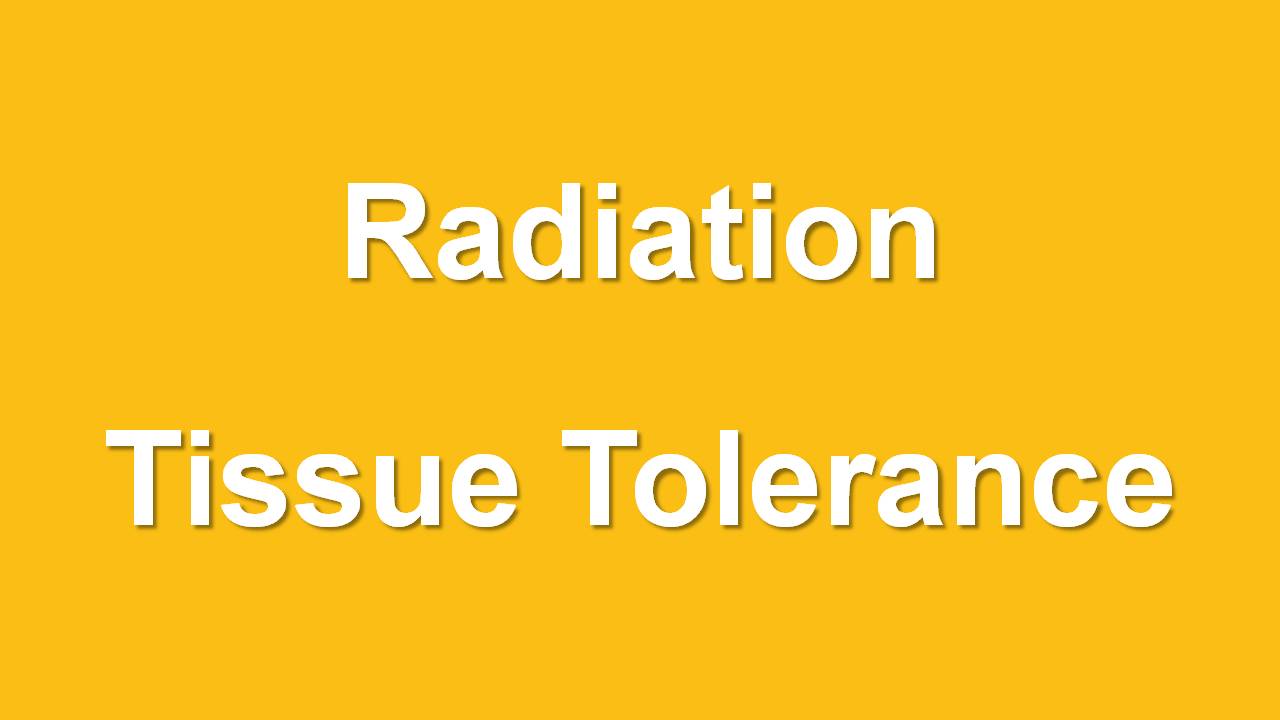Radiation Tissue Tolerance
Home
> Clinical Concepts In Radiation
Oncology > Tissue Tolerance
Tissue tolerance refers to the body’s ability to tolerate radiation exposure without adverse effects. Adverse effects refer to the radiation dose a specific body organ (like the lungs) can receive before it fails. Dose tolerance values in tissue tolerance tables usually apply to conventional fractionation for both photon as well as electron external beam radiation therapy treatments.
TD5/5 (pronounced five-five) as well as TD50/5 (pronounced fifty-five) are the original methods of providing organ tissue tolerance doses. TD5/5 refers to a radiation dose at which a particularly adverse outcome (like transverse myelopathy) would be experienced by an organ (like the spinal cord) 5% of the time in a 5-year period. While TD50/5 refers to a radiation dose at which a particularly adverse outcome would be experienced by an organ 50% of the time in a 5-year period.
The serial or parallel nature of an organ also impact the organs’ ability to tolerate radiation exposure. A parallel organ only fails completely when the entirety of the organ is irradiated. Examples of parallel organs are the lungs and kidneys. In contrast, a serial organ fails completely when only a portion of it volume is irradiated. Examples of serial organs are the spinal cord and lens of the eye.
Organ volume effects means an organs’ ability to tolerate a radiation dose depends on if the whole organ or a portion of the organ receives a radiation exposure. A portion of parallel organ (like the lung) may be irradiated and fail while other parts of the lungs not exposed to radiation continue to function. In contrast, if a portion of serial organ (like the spinal cord) is irradiated while other parts of the spinal cord are not exposed the entire organ fails to function.
A dose volume histogram; DVH, is commonly used as a treatment planning evaluation tool to review organ volume effects versus radiation exposure. The y-axis of a DVH is labeled organ volume while the x-axis is labeled organ dose.
Over time, our understanding of tissue tolerance has evolved and new terms have emerged. The objectives of radiation therapy to effectively treat cancer while preserving normal tissue remains the same. Adverse effects have been better described as organ toxicity. Organ toxicity refers to the specific degrees to which radiation has damaged a tissue.
The term normal tissue complication probability (referred to as NTCP) better describes the relationship between radiation exposure to tissue toxicity. NTCP accounts for volume effects as well as the serial and/or parallel nature of organs.
The term tumor control probability (referred to as TCP) is defined as the probability that a prescribed dose of radiation therapy controls or eradicated a tumor. The prescribed dose is specified in terms of total dose, treatment days (or fractions), as well as the daily dose.
The term generalized equivalent uniform dose (referred to as GEUD) is a dose term that better describes organ volume effects. The GUED terms allows the conversion of a partial organ volume irradiation exposure to an equivalent dose had the entire organ received radiation. The GUED term is useful for dose-volume toxicity determination.
A systematic literature review of external beam radiation exposure data versus patient tissue tolerance treatment outcomes resulted in QUANTEC findings. The term QUANTEC refers to a quantitative analysis of normal tissue effects in radiation oncology clinics. QUANTEC is based on 3D dose / volume (DVH) treatment findings.
In clinical treatment planning terms this means is that instead of evaluating a radiation therapy treatment plan using a single TD5/5 value on a DVH, multiple tissue tolerance dose and volume points are used to evaluate a treatment plan. Each normal tissue tolerance dose and volume point is specifically related to a normal tissue complication toxicity.
Home > Clinical Concepts In Radiation Oncology >Radiation Tissue Tolerance
Fourteen; 14 questions out of the 55
questions in the Clinical Concepts in Radiation Oncology content area come from
the Radiation Tissue Tolerance sub-topic.
Can we please get your advice on this one question?
- Tolerance Levels
- Adverse Effects
- Dose to Critical Structures
- Radiological Factors
- Biological Factors
- Medical Factors
- Other Factors
- Contribution from Other Sources
Home > Clinical Concepts In Radiation Oncology >Radiation Tissue Tolerance
FREE Infographic What successful people believe. What successful people do
Dictionary of Cancer Terms
Need help understanding a word? Here is an electronic resource that gives meaning to Cancer terms and their usage.

StrengthsFinder 2.0
